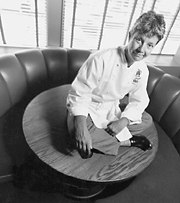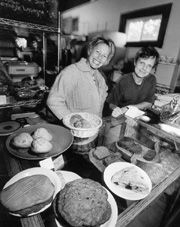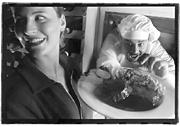This Green Lake eatery wants to be that place where everybody knows your name.
We stepped into Six Degrees preoccupied and moody from a long day, and found ourselves in a restaurant that wanted nothing more than to change that.
“How ya doing this evening?” chirped the hostess at the door. “Was it a good experience for you?” burbled our waiter at the end of the meal. Six Degrees, the glossy new pub/cafe on the west shore of Green Lake, doesn’t see itself so much as a restaurant—the owners bristle at the very word—as a relationship enhancement zone.
“The word ‘restaurant’ is just too average,” explains co-owner and conceiver Tom Church. “It doesn’t convey a neighborhood feel, a place for connection, that ‘Third Place’ away from home.”
Six Degrees
7900 E Green Lake Dr N, 523-1600 lunch, dinner daily major credit cards, checks
What the former camera store executive had in mind was an upscale drop-in neighborhood hangout with a long list of beers and wines, and food that’s more than an afterthought, like his favorite haunt, the Two Bells Tavern. But don’t call Six Degrees a tavern, either. “The word ‘tavern’ has old, outdated connotations of a place done in different shades of brown,” corrects Church. His partner Rod Pearson elaborates: “When we began work on this place we wanted to redefine what an American tavern is supposed to be.”
So two years ago, Church and Pearson launched an elaborate research mission. They visited their favorite neighborhood prototypes—the Two Bells, 74th Street Ale House, Maple Leaf Bar & Grill—and several outposts of McMenamin’s, the homegrown pub chain out of Portland. Missing from these funky joints, they determined, was a suitably refined aesthetic. Church and Pearson envisioned energetic colors, natural light, a buoyant contemporaneity.
Whereas most pubs and alehouses revolve around their libations, Church and Pearson saw instead what Pearson calls a “food-driven pub.” (But don’t call Six Degrees that, either: the restaurateurs finally settled on “spirited neighborhood kitchen.”) They hired as third partner chef Brian Poor, a local chef late of Chandler’s Crab House, to pilot menu development—a job he undertook using an unconventional spin on focus groups. “Lots of restaurants use professional menu consultants, but we wanted the average Joe’s opinion,” Poor explains. “We’d have tastings at my house; our friends and people off the street come in to sample the food.”
What did the research yield? “It had to be comfortable, recognizable food—but with an upscale twist,” reports Poor. Focus groups turned up their noses at cheese bread, for instance—too plebeian—but adored his mother’s recipe for rinsed sauerkraut salad. “The food had to be full-flavored, so we use a lot of beer and wine in our cooking. We knew we’d have burgers and great sandwiches.” Except Church’s fave—a rendition of the Two Bells’ legendary sausage sandwich—which was nixed for lack of interest. “We knew we’d have in-house desserts and we knew the nosh list was real important. People had to be able to come in, spend $5 to $8, and leave satisfied.” Indeed, the most consistent finding from the focus groups was that people did not want to spend more than $10 for a meal in a neighborhood restaurant.
Meanwhile, Church was employing a similar strategy on naming the place. “He’d be at a baseball game or walking around Green Lake and ask people, ‘What do you think of such-and-such a name?'” chuckles Poor. In collaboration with their design firm, the partners spent months tossing around possibilities. According to Church, some were “fun, risky, and evocative of cooking,” like Sacred Apron, or Bent Fork, or the finalist in this category, Wet Elbow. Other nominees were “catchy words, trendy words,” like Default. Signifying… what? “Signifying nothing,” clarifies Church. “You can take any name and define it relative to your concept.” Tommy C’s, after Church, was another close contender. “It sounded very ‘neighborhood’ to people, but also a little rough.”
“When the name Six Degrees hit the table, we all kind of raised our eyebrows,” Church continues. “Several of us knew the ‘Six Degrees of Separation’ theory from the play and the movie of the same title—that we are each connected to everyone else by no more than six relationships. It’s a neutral name, a fun name, and people are curious about it.” Mostly, it captured the spirit of friendliness and community that Church and his partners wanted most for their restau… er, “spirited neighborhood kitchen.”
Aside from the decorative refinement, that friendliness is the first thing one encounters upon stepping into Six Degrees. Indeed, the place appears to be staffed almost exclusively by Friends. We visited twice, six months after its summer opening, and encountered a fleet of chipper, Matthew Perry and Jennifer Anistonlike youth rigorously trained in the obsequious arts of scripted service and customer mood enhancement (Pearson hails from Mick McHugh and Tim Firnstahl’s F.X. McRory’s empire). Chef Poor tells me a staffer recently came to him frustrated about his job performance. “I asked him, ‘Are ya having fun?'” recalls Poor. “Because that’s what it’s all about: Have some fun and make sure the guests have fun. That’s our no. 1 priority!”
Food, it turns out, falls somewhere behind. On our visits we ran across a few fine dishes: moist panko-breaded fish ‘n’ chips ($6.96); an appetizer called the Round, consisting of a soft Frisbee of Middle Eastern bread with three intensely flavorful spreads ($5.56); a berry-strewn mascarpone cheesecake whose extravagant scrumptiousness could retire tiramisu for good ($4.96). We also encountered some blunders: smoked and grilled-to-death tiger prawns over a goopy Caesar salad ($6.96); a New York steakbleu cheese ciabatta (Six Degrees-ese for sandwich, $7.96) offering loads of flavor but too little lubrication. Not to mention a whopping missed opportunity for a place called Six Degrees: no “Kevin Bacon Burger.”
Mostly what we found were oddly conceived dishes bearing all the earmarks of design by committee. Off the “Noshes” list we ordered the Wild Boar Ribs Teaser ($6.96): tender ribs swathed in a sweet, sweet glaze over a sweet, sweet pile of “Five Bean Beans.” The whole schmear tasted of fruit. The turkey burger ($7.66) was a thick patty of turkey loaf, heavy on the sage, bedecked with cheese, spicy mustard, and cranberry relish, and served on a rosemary bun. Whoa—tastebud chaos. With it came too-sweet coleslaw and seasoned snowshoe fries on the rubbery side.
A fancy rotisserie being the centerpiece of the kitchen, we ordered the ale-honey-mustard-glazed rotisserie chicken ($9.66) and finally put it together: At Six Degrees “full-flavored” appears to be code for “way too sweet.” Paired with sophisticated sides—mashed potatoes with a fancy demiglace, Poor’s mom’s sauerkraut salad—the plate seemed schizophrenic, caught in an awkward limbo between upscale and down-home.
Which gets at Six Degrees’ larger problem. It’s designed, scripted, and focus-grouped—down to the last romaine leaf—to be the kind of place, alas, no designer, script, or focus group can create. Real neighborhood “Third Places” spring organically out of the favorable soils of place and quality and blessed good luck; they are anointed by their communities and preserved through spontaneous neighborhood enthusiasm. They are by definition—think of the Maple Leaf Grill, the Virginia Inn—homegrown. Six Degrees, though a pretty place from which to gaze at Green Lake while being served with startling good cheer, isn’t home-grown: the outfit that runs it, the Belltown Corp., calls it an “interactive dining concept,” for goodness’ sake. That doesn’t mean that one day the spark of real community couldn’t ignite there. It just means that in the meantime, you can call Six Degrees a restaurant.







